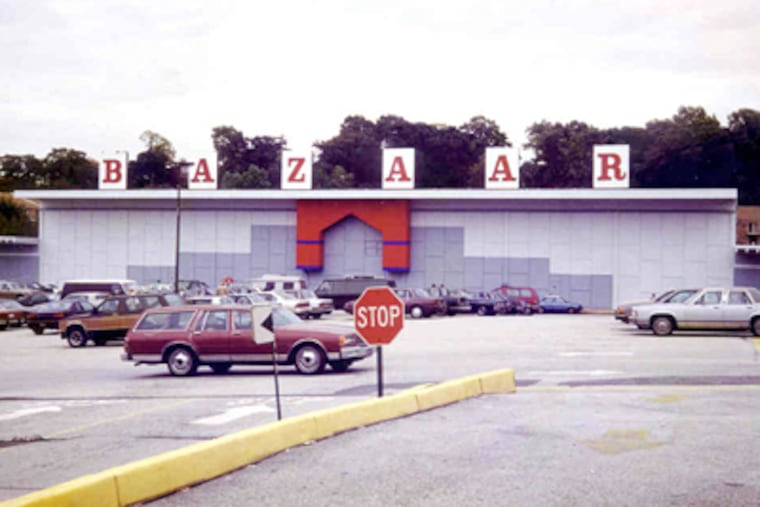Documentary captures bizarreness of the Bazaar
IF YOU NEVER set foot in the Bazaar, it's tough to understand its place in Delaware County's collective memory, and why the question "Remember the Bazaar?" can still set off an hour-long discussion 17 years after its doors closed.

IF YOU NEVER set foot in the Bazaar, it's tough to understand its place in Delaware County's collective memory, and why the question "Remember the Bazaar?" can still set off an hour-long discussion 17 years after its doors closed.
The Bazaar of All Nations, as it was formally named, was a massive indoor shopping center on the border of Upper Darby and Clifton Heights, a blue-collar precursor to the modern mall.
Built in 1960 on the grounds of an old mental hospital, the Bazaar was a semi-surreal maze of pegboard, wood paneling, chicken wire and miles of fluorescent lights.
Wander around long enough and you'd find what you needed. Maybe it was a part for your broken lawn mower or school supplies for your kids. Maybe just a cold beer and a soft pretzel from Bernie's. Or maybe your future wife.
Dubbed the "Twilight Zone" by some local cops, the Bazaar was part farmer's market, part carnival and part something unique that seems difficult to identify today through the haze of nostalgia.
In the new documentary "Bazaar of All Nations," director Melissa Whitely and co-producers Patrick Manley and Brendan O'Riordan delve into why the Bazaar was not merely an early shopping mall but the "center of the universe" for some suburban-Philadelphia residents.
The documentary, which features never-before-seen photos and video footage, premieres tonight at Lansdowne's Cinema 16:9 and will be available on DVD next week.
"People would break down in tears about their experiences at the Bazaar," Manley said. Most of its merchants, he said, described their years there as "the greatest time of their life. They cherished that time more than anything else they've ever done."
Manley is an editor in medical publishing; O'Riordan, a chemical engineer. Each is a 33-year-old Collingdale native with a childhood full of Bazaar memories.
The Monsignor Bonner grads teamed up with Whitely, of New Jersey-based White Lyte Productions, and began to search for Bazaar memorabilia and dig through newspaper archives for articles and undeveloped photos. They filmed about 45 hours of interviews.
"I think it's the definitive history of the place," O'Riordan said.
But why would anyone still care about this place on Baltimore Pike that no longer exists? Why has the documentary's Facebook page attracted 10,400 fans before its premiere, while only 1,200 people "like" the Springfield Mall's page?
First off, the Bazaar had everything.
"You can have lunch at one place, you get a belt buckle at the place next door and you can get some 8-track tapes next door to that," comedian Joe Conklin recalls in the documentary. "Right next to the guy making your hamburger was a guy making keys. And nobody blinked an eye. It was all normal. It was crazy."
Unlike the chains that fill today's malls, the Bazaar was composed mostly of independent store owners who served their customers directly. It was a true one-stop shop, where you could throw a load of laundry in the wash while flipping through the new vinyl at Jerry's Records.
"Laundromat, tailor, dry cleaners, barber, salon, nails," O'Riordan said of the personal-care destinations mixed in with the retail shops.
If it sounds a little weird, that's because it was. Enough to make it memorable: The mysterious knight's armor standing above the entrance, the self-playing piano, the talking parrots, "Iggy" the Panamanian iguana, and the kinkajou that once escaped. And "Mike" the monkey, who, for reasons unknown, did not approve of women wearing skirts.
"He had his moments," Victor Mele, owner of the Bazaar's pet shop, says in the documentary.
Under the management of the late Aaron Milner, the Bazaar constantly brought in celebrities to drum up business: Danny Thomas, George Hamilton, Captain Noah, original Munchkin Meinhardt Raabe, Sally Starr, Al Alberts, Larry Ferrari. The list goes on. It also was a major destination for politicians, including Richard Nixon and Robert F. Kennedy.
Wacky promotional stunts were the norm. To celebrate its first anniversary, in 1961, for example, the Bazaar offered a family $2,000 to live in a Cold War-era bomb shelter in the parking lot for a week. People stared into the shelter's window around the clock, waiting for the curtain to part so that they could get a glimpse at its occupants.
"It was the prototype for reality TV," Whitely said.
After the Bazaar closed in 1993, many merchants couldn't bear to watch its demolition. Wayne Gallagher, a maintenance worker, recalls in the documentary how they turned the key on the main doors for the last time New Year's Eve: "It was like death."
The 1-hour, 45-minute documentary, which features interviews with former Eagle Vince Papale, radio hosts Chuck van Zyl and Big Daddy Graham, easily could have been twice as long, the producers said. The DVD is packed with extras, including a video walkaround of the entire interior and exterior, a 3-D model, and additional photos and interviews.
Whitely, who, unlike Manley and O'Riordan, never visited the Bazaar, said that the documentary isn't just a sentimental walking tour or a history lesson. It's about trading the Bazaar's camaraderie for impersonal websites and sterile malls - and questioning whether that should be considered progress.
"The message," she said, "is, 'What have we lost?' "
Visit www.thebazaarofallnations.com for screening and DVD information.